Chem133 week 6 - Study guides, Class notes & Summaries
Looking for the best study guides, study notes and summaries about Chem133 week 6? On this page you'll find 16 study documents about Chem133 week 6.
All 16 results
Sort by
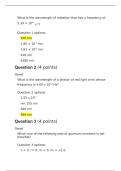
-
CHEM133 Week 6 Lesson 3 Quiz
- Exam (elaborations) • 16 pages • 2023
- Available in package deal
-
- $29.99
- + learn more
1. Question: What is the wavelength of radiation that has a frequency of 5.39 × 1014 s–1? 2. Question: What is the wavelength of a photon of red light (nm) whose frequency is 4.64 x 1014 Hz? 3. Question: Which one of the following sets of quantum numbers is not possible? 4. Question: In Bohr's atomic theory, when an electron moves from one energy level to another energy level more distant from the nucleus: 5. Question: Calculate the wavelength of a neutron that has a velocity of 250 cm/s...
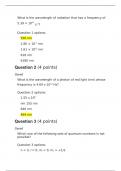
-
CHEM133 Week 6 Lesson 3 Quiz
- Exam (elaborations) • 16 pages • 2023
-
- $22.49
- + learn more
1. Question: What is the wavelength of radiation that has a frequency of 5.39 × 1014 s–1? 2. Question: What is the wavelength of a photon of red light (nm) whose frequency is 4.64 x 1014 Hz? 3. Question: Which one of the following sets of quantum numbers is not possible? 4. Question: In Bohr's atomic theory, when an electron moves from one energy level to another energy level more distant from the nucleus: 5. Question: Calculate the wavelength of a neutron that has a velocity of 250 cm/s...
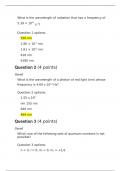
-
CHEM133 Week 6 Lesson 3 Quiz Questions and Answers APU
- Exam (elaborations) • 16 pages • 2023
- Available in package deal
-
- $23.99
- + learn more
1. Question: What is the wavelength of radiation that has a frequency of 5.39 × 1014 s–1? 2. Question: What is the wavelength of a photon of red light (nm) whose frequency is 4.64 x 1014 Hz? 3. Question: Which one of the following sets of quantum numbers is not possible? 4. Question: In Bohr's atomic theory, when an electron moves from one energy level to another energy level more distant from the nucleus: 5. Question: Calculate the wavelength of a neutron that has a velocity of 250 cm/s...
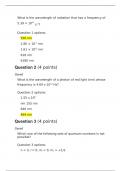
-
CHEM133 Week 6 Lesson 3 Quiz
- Exam (elaborations) • 16 pages • 2023
-
- $21.49
- + learn more
1. Question: What is the wavelength of radiation that has a frequency of 5.39 × 1014 s–1? 2. Question: What is the wavelength of a photon of red light (nm) whose frequency is 4.64 x 1014 Hz? 3. Question: Which one of the following sets of quantum numbers is not possible? 4. Question: In Bohr's atomic theory, when an electron moves from one energy level to another energy level more distant from the nucleus: 5. Question: Calculate the wavelength of a neutron that has a velocity of 250 cm/s...
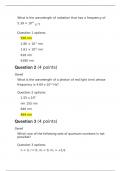
-
CHEM133 Week 6 Lesson 3 Quiz
- Exam (elaborations) • 16 pages • 2023
-
Available in package deal
-
- $35.11
- + learn more
1. Question: What is the wavelength of radiation that has a frequency of 5.39 × 1014 s–1? 2. Question: What is the wavelength of a photon of red light (nm) whose frequency is 4.64 x 1014 Hz? 3. Question: Which one of the following sets of quantum numbers is not possible? 4. Question: In Bohr's atomic theory, when an electron moves from one energy level to another energy level more distant from the nucleus: 5. Question: Calculate the wavelength of a neutron that has a velocity of 250 cm/s...
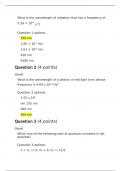
-
CHEM133 Week 6 Lesson 3 Quiz (All Correct)
- Exam (elaborations) • 16 pages • 2023
-
Available in package deal
-
- $30.48
- + learn more
1. Question: What is the wavelength of radiation that has a frequency of 5.39 × 1014 s–1? 2. Question: What is the wavelength of a photon of red light (nm) whose frequency is 4.64 x 1014 Hz? 3. Question: Which one of the following sets of quantum numbers is not possible? 4. Question: In Bohr's atomic theory, when an electron moves from one energy level to another energy level more distant from the nucleus: 5. Question: Calculate the wavelength of a neutron that has a velocity of 250 cm/s...

-
CHEM133 Week 6 Lesson 3 Quiz
- Exam (elaborations) • 16 pages • 2023
-
- $19.49
- + learn more
1. Question: What is the wavelength of radiation that has a frequency of 5.39 × 1014 s–1? 2. Question: What is the wavelength of a photon of red light (nm) whose frequency is 4.64 x 1014 Hz? 3. Question: Which one of the following sets of quantum numbers is not possible? 4. Question: In Bohr's atomic theory, when an electron moves from one energy level to another energy level more distant from the nucleus: 5. Question: Calculate the wavelength of a neutron that has a velocity of 250 cm/s...
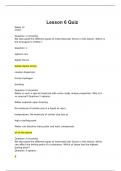
-
CHEM133 Week 13 Lesson 6 Quiz.docx
- Exam (elaborations) • 13 pages • 2023
- Available in package deal
-
- $29.99
- + learn more
1. Question: We discussed the different types of intermolecular forces in this lesson. Which is the strongest in CF2H2 ? 2. Question: Water is such a special molecule with some really unique properties. Why is it so unusual? 3. Question: We discussed the different types of intermolecular forces in this lesson, which can affect the boiling point of a substance. Which of these has the highest boiling point? 4. Question: If you have 2.00 x 103 J of energy, what mass (g) of solid butane (C4H10O) ...
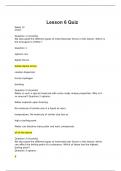
-
CHEM133 Week 13 Lesson 6 Quiz Questions and Answers APU
- Exam (elaborations) • 13 pages • 2023
- Available in package deal
-
- $23.99
- + learn more
1. Question: We discussed the different types of intermolecular forces in this lesson. Which is the strongest in CF2H2 ? 2. Question: Water is such a special molecule with some really unique properties. Why is it so unusual? 3. Question: We discussed the different types of intermolecular forces in this lesson, which can affect the boiling point of a substance. Which of these has the highest boiling point? 4. Question: If you have 2.00 x 103 J of energy, what mass (g) of solid butane (C4H10O) ...

-
CHEM133 Week 13 Lesson 6 Quiz
- Exam (elaborations) • 13 pages • 2023
-
- $22.49
- + learn more
1. Question: We discussed the different types of intermolecular forces in this lesson. Which is the strongest in CF2H2 ? 2. Question: Water is such a special molecule with some really unique properties. Why is it so unusual? 3. Question: We discussed the different types of intermolecular forces in this lesson, which can affect the boiling point of a substance. Which of these has the highest boiling point? 4. Question: If you have 2.00 x 103 J of energy, what mass (g) of solid butane (C4H10O) ...

Do you wonder why so many students wear nice clothes, have money to spare and enjoy tons of free time? Well, they sell on Stuvia! Imagine your study notes being downloaded a dozen times for $15 each. Every. Single. Day. Discover all about earning on Stuvia


